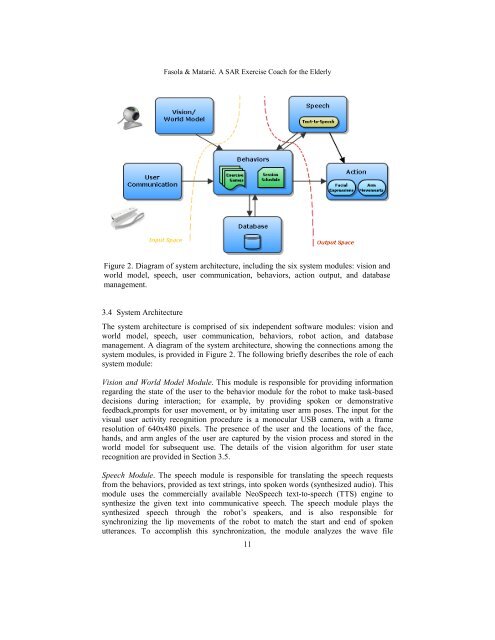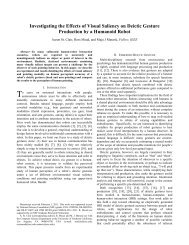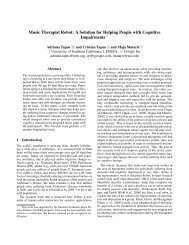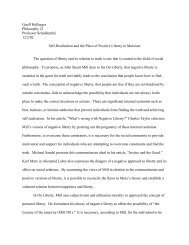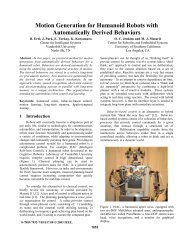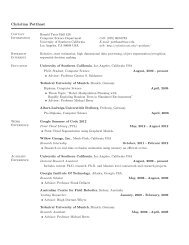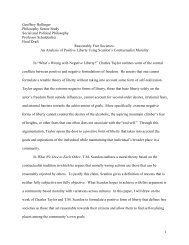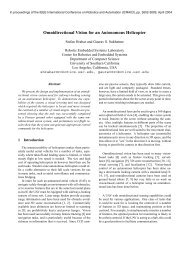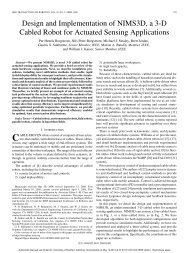Fasola & Matarić. A SAR <strong>Exercise</strong> <strong>Coach</strong> <strong>for</strong> <strong>the</strong> <strong>Elderly</strong>job!” or “Now you’ve got <strong>the</strong> hang of it.”). This game has <strong>the</strong> fastest pace of <strong>the</strong> fourexercise games, as <strong>the</strong> users generally complete <strong>the</strong> requested gestures quickly.3.3.2 Sequence GameThe Sequence game is similar to <strong>the</strong> Workout game in that <strong>the</strong> robot demonstrates armexercises <strong>for</strong> <strong>the</strong> user to repeat. However, instead of showing each gesture <strong>for</strong> <strong>the</strong> user toper<strong>for</strong>m only once, <strong>the</strong> robot demonstrates two gestures <strong>for</strong> <strong>the</strong> user to repeat in sequence<strong>for</strong> three repetitions (resulting in six gesture completions per sequence). The robot keepsverbal count of <strong>the</strong> number of iterations of <strong>the</strong> sequence per<strong>for</strong>med in order to guide <strong>the</strong>user, while providing feedback throughout (e.g., after <strong>the</strong> user completes <strong>the</strong> first pair, <strong>the</strong>robot says “One,” and upon completion of <strong>the</strong> second pair, it says “Two”). This gamerequires <strong>the</strong> user to remember <strong>the</strong> gesture pair while completing <strong>the</strong> sequence, in additionto promoting periodic movements from <strong>the</strong> users. While slower-paced than <strong>the</strong> Workoutgame, <strong>the</strong>se periodic movements are physically challenging and can cause <strong>the</strong> users tophysically exert <strong>the</strong>mselves more than in any of <strong>the</strong> o<strong>the</strong>r three games.3.3.3 Imitation GameIn <strong>the</strong> Imitation game, <strong>the</strong> roles of <strong>the</strong> user and robot are reversed relative to <strong>the</strong> Workoutgame: The user becomes <strong>the</strong> exercise instructor, showing <strong>the</strong> robot what to do. The robotencourages <strong>the</strong> user to create his/her own arm gesture exercises and imitates usermovements in real time. Since <strong>the</strong> roles of <strong>the</strong> interaction are reversed, with <strong>the</strong> robotrelinquishing control of <strong>the</strong> exercise routine to user, <strong>the</strong> robot does not provide instructivefeedback on <strong>the</strong> exercises. However, <strong>the</strong> robot does continue to speak and engage <strong>the</strong> userby means of encouragement, general commentary, humor, and movement prompts ifnecessary. As <strong>the</strong> robot imitates <strong>the</strong> user’s movements in real time, <strong>the</strong> interaction in thisgame is <strong>the</strong> most fluid and interactive of all <strong>the</strong> exercise games. Fur<strong>the</strong>rmore, this is <strong>the</strong>only game designed to promote user autonomy and creativity in <strong>the</strong> exercise task. Both of<strong>the</strong>se characteristics are beneficial <strong>for</strong> increasing <strong>the</strong> user’s intrinsic motivation to engagein <strong>the</strong> task.3.3.4 Memory GameThe goal of <strong>the</strong> Memory game is <strong>for</strong> <strong>the</strong> user to try and memorize an ever-longersequence of arm gesture poses, and thus compete against his/her own high score. Thesequence is determined at <strong>the</strong> start of <strong>the</strong> game and does not change <strong>for</strong> <strong>the</strong> duration of<strong>the</strong> game. The arm gesture poses used <strong>for</strong> each position in <strong>the</strong> sequence are chosen atrandom at run time, and <strong>the</strong>re is no inherent limit to <strong>the</strong> sequence length, <strong>the</strong>reby making<strong>the</strong> game challenging <strong>for</strong> users at all skill levels. Each time <strong>the</strong> user successfullymemorizes and per<strong>for</strong>ms all shown gestures without help from <strong>the</strong> robot, <strong>the</strong> robot shows<strong>the</strong> user two additional gestures to add to <strong>the</strong> sequence, and hence <strong>the</strong> game progresses indifficulty. The robot helps <strong>the</strong> user to keep track of <strong>the</strong> sequence by counting along wi<strong>the</strong>ach correct gesture and reminding <strong>the</strong> user of <strong>the</strong> correct poses, while demonstratingempathy upon user failure (e.g., “Oh, that’s too bad! Here is gesture five again.”). Thisgame is <strong>the</strong> most cognitively challenging of all <strong>the</strong> exercise games, and primarily servesto encourage competition with <strong>the</strong> user’s past per<strong>for</strong>mance.10
Fasola & Matarić. A SAR <strong>Exercise</strong> <strong>Coach</strong> <strong>for</strong> <strong>the</strong> <strong>Elderly</strong>Figure 2. Diagram of system architecture, including <strong>the</strong> six system modules: vision andworld model, speech, user communication, behaviors, action output, and databasemanagement.3.4 System ArchitectureThe system architecture is comprised of six independent software modules: vision andworld model, speech, user communication, behaviors, robot action, and databasemanagement. A diagram of <strong>the</strong> system architecture, showing <strong>the</strong> connections among <strong>the</strong>system modules, is provided in Figure 2. The following briefly describes <strong>the</strong> role of eachsystem module:Vision and World Model Module. This module is responsible <strong>for</strong> providing in<strong>for</strong>mationregarding <strong>the</strong> state of <strong>the</strong> user to <strong>the</strong> behavior module <strong>for</strong> <strong>the</strong> robot to make task-baseddecisions during interaction; <strong>for</strong> example, by providing spoken or demonstrativefeedback,prompts <strong>for</strong> user movement, or by imitating user arm poses. The input <strong>for</strong> <strong>the</strong>visual user activity recognition procedure is a monocular USB camera, with a frameresolution of 640x480 pixels. The presence of <strong>the</strong> user and <strong>the</strong> locations of <strong>the</strong> face,hands, and arm angles of <strong>the</strong> user are captured by <strong>the</strong> vision process and stored in <strong>the</strong>world model <strong>for</strong> subsequent use. The details of <strong>the</strong> vision algorithm <strong>for</strong> user staterecognition are provided in Section 3.5.Speech Module. The speech module is responsible <strong>for</strong> translating <strong>the</strong> speech requestsfrom <strong>the</strong> behaviors, provided as text strings, into spoken words (syn<strong>the</strong>sized audio). Thismodule uses <strong>the</strong> commercially available NeoSpeech text-to-speech (TTS) engine tosyn<strong>the</strong>size <strong>the</strong> given text into communicative speech. The speech module plays <strong>the</strong>syn<strong>the</strong>sized speech through <strong>the</strong> robot’s speakers, and is also responsible <strong>for</strong>synchronizing <strong>the</strong> lip movements of <strong>the</strong> robot to match <strong>the</strong> start and end of spokenutterances. To accomplish this synchronization, <strong>the</strong> module analyzes <strong>the</strong> wave file11


